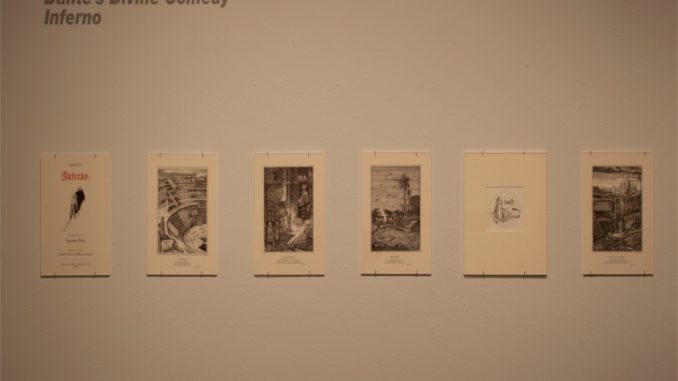
When I went to see “Dante’s Divine Comedy and Other Works” by Sandow Birk earlier this semester, I figured I knew what I was in for. After taking Art History Professor Ben David’s course on the subject my sophomore year, I was pretty familiar with how Birk had reimagined Dante’s epic through a series of illustrations modeled after Gustave Dore’s 19th century prints. I’d even seen the movie, cleverly animated through a collection of handmade puppets. I thought I knew what to expect as I walked through the doors of the Hoffman Gallery. But rather than entering a black and white realm of urban hellfire, I found myself surrounded by the soft colors of Arabic illuminated manuscripts.
Though his “Divine Comedy” took top billing at this spring’s exhibition, Birk’s “American Qur’an” is an equally impressive work — a translation of Islam’s central religious text illustrated by scenes from contemporary American life. His attention to detail in both works is astounding, whether he is tinkering with Dore’s use of light or paying homage to the intricate borders of traditional Qur’ans. In Canto IV of Inferno, Birk shows how the virtuous pagans have been cut off from God’s love by depicting them as homeless individuals huddled under a bridge which blocks the light of a lamppost at the top of the image. On a painting of a flood from “American Qur’an,” the shimmering water overflows the frame and pools beneath the page numbers as survivors row down the street. Both projects present scenes from modern America, yet Birk’s techniques imbue his illustrations with the divinity at the heart of his subject matter.
Besides the artist and setting, however, these collections are strikingly different. Going between the two rooms of the gallery, I was struck by the stark contrast between “Divine Comedy” and “American Qur’an.” The first work is primarily a response to both Dante’s legacy and American life, and it conveys its cutting satire through crowded, active pieces. The second is a work of reverence, an attempt to provide context for a misrepresented faith with soothing colors and peaceful scenes.
According to David, these differences lie at the core of the exhibition.
“Having the two projects side by side, presenting how the artist maps and pictures the entire text of his source materials, really conveys the breadth and depth of Birk’s work,” David said. “We’ve been wanting to do something like this for a long time. I wish we’d done it sooner.”
The Hoffman Gallery’s current exhibition, the last curated by Gallery Director Linda Tesner, holds special significance for many at LC. David’s Visual Representations of Dante course attracts students from a multitude of majors, and his spring E&D class reads sections from the Qur’an at the beginning of the term. When Birk visited the gallery on Jan. 24, I was moved by how many familiar faces had come not only to enjoy his masterpieces, but to further explore subjects encountered in their studies — a true testament to the exhibition’s triumph.
Written by Stephen Hanley.
Subscribe to the Mossy Log Newsletter
Stay up to date with the goings-on at Lewis & Clark! Get the top stories or your favorite section delivered to your inbox whenever we release a new issue.

Leave a Reply